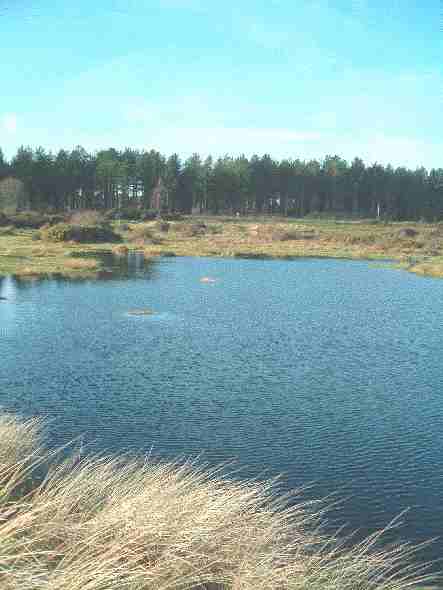
GLANTRAETH SITE OF SPECIAL SCIENTIFIC INTEREST

What is ‘special’ about the wildlife at Glantraeth SSSI?
Glantraeth SSSI has one special feature:
Great Creasted Newt
As well as the feature listed above, Glantraeth has other features that contribute to the special interest. These include open water, dune grassland and scrub which support other amphibians (palmate newt, common frog and common toad) along with several uncommon plants including early sand grass, meadow saxifrage, round leaved wintergreen and variegated horsetail. Unless specified below, management of this site should aim to look after these as well as the listed features of interest.
What do we want Glantraeth to look like?
|
Male Great Crested Newt |
There should be at least three main ponds on the site with a scattering of smaller seasonal pools. Clear water should be present in the main ponds all year round in most years. The ponds should support a range of insects and submerged and floating water plants. There should be areas of open water over bare substrate (where newts can practice their elaborate night-time courtship displays) as well as more densely vegetated areas for egg laying. |
|
In spring, the males display on the bottom of less vegetated part of the pond and the females wrap their yellowish eggs in the leaves of water forget-me-not and other water plants. Great crested newts should breed here each year, along with frogs, toads and palmate newts. |
PalmateNewt |
|
Round leaved wintergreen |
The land surrounding the ponds should be undulating, with a varied sward height, providing a variety of terrain including seasonally flooded wet ground and dry ridges and hummocks suitable for feeding, resting and hibernating amphibians. Around patches of bare sand in rabbit scrapes the early sand grass should grow, while meadow saxifrage will be seen in short turf. Round leaved wintergreen and variegated horsetail should occur in seasonally flooded areas. Small areas of blackthorn scrub will be tolerated and scattered clumps of gorse should be present throughout the site. |
What management is needed on Glantraeth SSSI, and why?
Although Glantraeth is an excellent place for wildlife, it is not entirely ‘natural’. It will be essential to continue management, and CCW’s aim is to work with you to achieve this. We place a great importance on our relationships with owners and occupiers, because without your help, it will be impossible for us to safeguard the special features on your land.
There are a number of different factors that could damage the special feature at Glantraeth if they are not properly managed. These are the ones we regard as most important:
There must be sufficient water must be in the main ponds for the period February through to early August. This will enable most newt tadpoles time to develop into young adults. Drying of the main pools, one year in ten, may be tolerated (see below).
Gradually with time ponds tend to fill in due to the processes of siltation. This will make the ponds susceptible to drying out before the newt young have emerged from the water. The creation of additional ponds on the site would allow existing ponds to be cleaned in rotation. This would avoid the threat to the whole great crested newt population due to drying out of one or two crucial ponds.
Plant nutrients can encourage algae, which cloud the water at the expense of other water plants making the ponds unusable for the great crested newts. Fertilisers, including land-spreading of effluent, should therefore be avoided anywhere on the site as they could pollute the pond water. Silage feeding on the site should also be avoided as it will encourage livestock to spread highly enriched material and faeces in or near the water. Pollution by road run off should also be avoided as it may contain oil or other toxins
Fish, even sticklebacks, eat tadpoles and sometimes adult amphibians. Good breeding sites are fish-free, possibly due to occasional drying-out. Sticklebacks are abundant in the nearby Llyn Parc Mawr and the threat of transfer into the newt pools is a major concern. Waterfowl can also predate amphibians and should not be encouraged.
Light grazing by cattle or ponies is beneficial for the site. The livestock help the control of water plants around the margins of the ponds, maintaining bare sections used for newt courtship purposes. Grazing also helps maintain diverse rough areas next to pools so that they can support a range of dwelling areas and food (slugs, crane flies, dung flies and dung beetles). Different types of vegetation provide a range of refuges amongst tussock bases and under scrub. Tall, grassy vegetation has high levels of humidity during the day, whilst tree roots, dense shrubby vegetation and stony or broken ground can provide refuges under the surface. Diverse vegetation structure is best achieved through the light grazing by cattle or ponies.
Hibernation sites
Great crested newts usually hibernate on dry land, where they can escape from frost. This includes burying down cracks in the ground, under tree roots and rabbit burrows. The piles of inert rubble at Glantraeth may be useful for this, especially as they have vegetated over and still have access cracks.
Our knowledge of wildlife at Glantraeth is far from complete. It is possible that new features of value may appear and new management issues may arise in the future, whilst other issues may disappear. This statement is written with the best information we have now, but may have to change in the future as our understanding improves. Any information you can provide on the wildlife of your site, its management and its conservation would be much appreciated.
If you would like to discuss any aspect of your SSSI, or have any concerns about your SSSI, please contact your local CCW office.
Your local office is;
Cyngor Cefn Gwlad Cymru/Countryside Council for Wales
Llys y Bont,
Ffordd y Parc,
Parc Menai,
Bangor,
Gwynedd, LL57 4BN,
Fax: 01248 679259